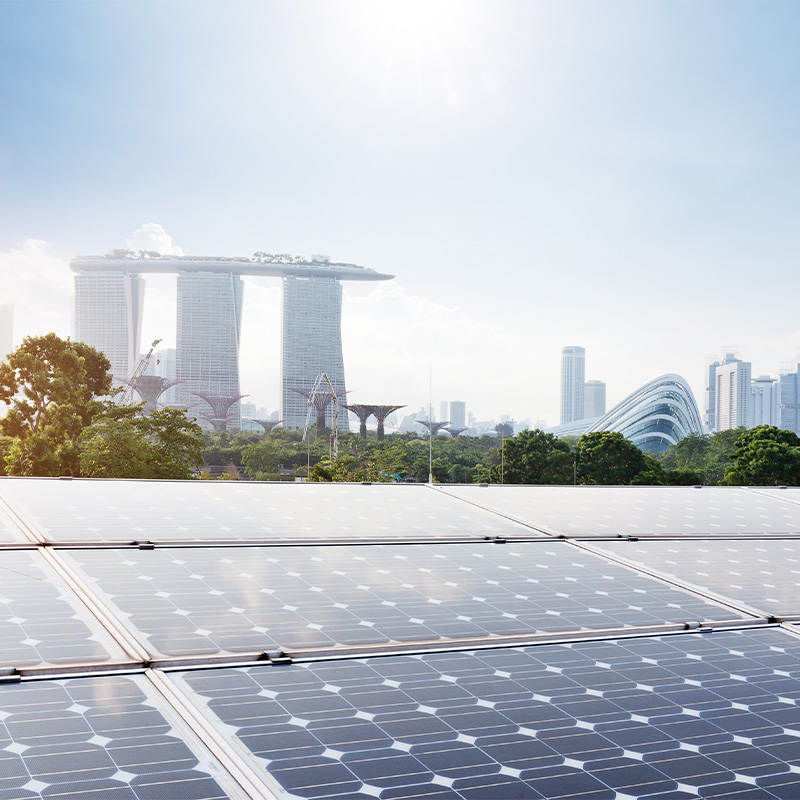
Singapore and Green Energy
Singapore and Green Energy
By Qihan Geng, Head of APAC, qihan@greenrecruitmentcompany.com
High achievers
Singapore is a real success story, it has East Asia’s highest per Capita GDP, it enjoys a fantastic reputation in areas such as rule of law, education and technology. From a business perspective, the World Bank has long ranked Singapore as one of the easiest places to do business. For this article, we aim to look at the ease of doing green business in Singapore and the current state of the local renewable energy industry.
Setting absolute targets and careful planning
Singapore has based its strategy on its strength, hitting targets. The Government’s Long-Term Emissions Development Strategy (LEDS) aims to cap emissions at 2030 levels, halve them by 2050 and then reach zero-emissions by the end of the century. The strategy allows little room for flexibility, having set the targets Singapore will hit them. It has taken a holistic approach to the economy to ensure that from buildings to industry it will be delivered. There has been some criticism that the plan is too lenient on the oil and gas industry, however it is clear that the plan is trying to balance the need for green transition with the economy’s current reliance on fossil fuels.
Integrated planning is a definite hallmark of Singaporean sustainability strategies. The Housing Development Board (HDB), has set targets to reduce energy consumption by 15% by 2030. This includes ensuring that 70% of all HDB housing blocks will have solar installed by 2030, any excess power generated will be fed straight back to Singapore’s grid.
Building sustainable infrastructure
Singapore, by 2021 will have a fully green public waterworks scheme, following the deployment of a 60MWp floating solar plant at the Tengeh reservoir. This follows rooftop solar installations at Bedok Waterworks, Changi Water Reclamation Plant, Choa Chua Kang Waterworks, Marina Barrage, WaterHub and the Tuas Desalination Plant.
Overcoming land shortage
Singapore has an obvious challenge in that the country lacks the land to run some of the usual renewable energy options that other countries would use. Singapore has looked instead to floating technology, the Tengeh reservoir mentioned previously is a good example of this. However perhaps the most impressive example of Singapore’s commitment to overcoming land shortage is its plan to collaborate with Australia.
The “Sun Cable” is a planned undersea cable linking the Tenant Creek solar development in Australia’s Northern Territory to Singapore. The development is expected to generate 3GW of energy. The project is highly ambitious and comes with a price tag of $20bn. The project is likely to go live at the later stages of this decade.
Taking a position on Hydrogen, boosting EVs
Few topics seem to be generating as much buzz in Asian renewables as green hydrogen. There is a clear emerging market for hydrogen, especially amongst some of the land poor countries of Asia for hydrogen as a path to reduced emissions. Singapore seems well placed for a leadership role in the Asian hydrogen sector, following the formation in the country of the APAC Hydrogen Association in February this year.
The hydrogen strategy is distinctly Singaporean. At present Singapore lacks a steady source of green hydrogen and is pushing better electric vehicle (EV) infrastructure. The essence of the strategy then is, first of all taking a long term view, green hydrogen might not be today’s answer for Singapore, but future developments may make it worthwhile – when that time comes, Singapore will be well placed to capitalise on the technology.
In relation to EVs, Singapore aims to phase out internal combustion engine vehicles by 2040. At present sales of EVs make up a small proportion of all car sales. To help encourage sales the government are pursuing a two-track strategy to improve infrastructure – ensuring existing slow charge facilities are maintained to boost interoperability whilst changing regulations to promote fast charging infrastructure.
Closing thoughts
It would be fair to say that Singapore was late to the party on green energy. However, it is also fair to say that Singapore is making up for lost time. Their approach to renewables is shrewd, maximising their own resources through rooftop and floating solar, whilst also looking to innovative solutions like the sun cable. They have also demonstrated flexibility in their approach to sustainable transport focusing on EVs but engaging with hydrogen as well. The country will need to review its approach to oil and gas soon, but the current plans offer much promise and have already shown a lot of action.
